The NVIDIA GeForce GTX 780 Ti Review
by Ryan Smith on November 7, 2013 9:01 AM ESTOverclocking
Finally, let’s spend a bit of time looking at the overclocking prospects for the GTX 780 Ti. Although GTX 780 Ti is now the fastest GK110 part, based on what we've seen with GTX 780 and GTX Titan there should still be some headroom to play with. Meanwhile there will also be the matter of memory overclocking, as 7GHz GDDR5 on a 384-bit bus presents us with a new baseline that we haven't seen before.
| GeForce GTX 780 Ti Overclocking | ||||
| Stock | Overclocked | |||
| Core Clock | 876MHz | 1026MHz | ||
| Boost Clock | 928MHz | 1078MHz | ||
| Max Boost Clock | 1020MHz | 1169MHz | ||
| Memory Clock | 7GHz | 7.6GHz | ||
| Max Voltage | 1.187v | 1.187v | ||
Overall our overclock for the GTX 780 Ti is a bit on the low side compared to the other GTX 780 cards we’ve seen in the past, but not immensely so. With a GPU overclock of 150MHz, we’re able to push the base clock and maximum boost clocks ahead by 17% and 14% respectively, which should further extend NVIDIA’s performance lead by a similar amount.
Meanwhile the inability to unlock a higher boost bin through overvolting is somewhat disappointing, as this is the first time we’ve seen this happen. To be clear here GTX 780 Ti does support overvolting – our card offers up to another 75mV of voltage – however on closer examination our card doesn’t have a higher bin within reach; 75mV isn’t enough to reach the next validated bin. Apparently this is something that can happen with the way NVIDIA bins their chips and implements overvolting, though this the first time we’ve seen a card actually suffer from this. The end result is that it limits our ability to boost at the highest bins, as we’d normally have a bin or two unlocked to further increase the maximum boost clock.
As for memory overclocking, we were able to squeeze out a bit more out of our 7GHz GDDR5, pushing our memory clock 600MHz (9%) higher to 7.6GHz. Memory overclocking is always something of a roll of the dice, so it’s not clear here whether this is average or not for a GK110 setup with 7GHz GDDR5. Given the general drawbacks of a wider memory bus we wouldn’t be surprised if this was average, but at the same time in practice GK110 cards haven’t shown themselves to be as memory bandwidth limited as GK104 cards. So 9%, though a smaller gain than what we’ve seen on other cards, should still provide GTX 780 Ti with enough to keep the overclocked GPU well fed.
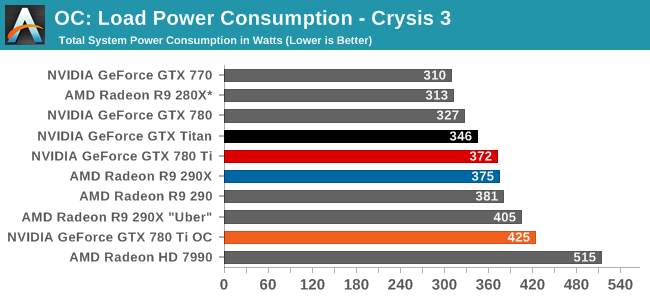
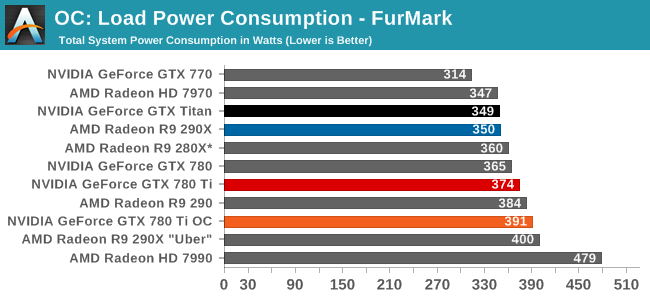
Starting as always with power, temperatures, and noise, we can see that overclocking GTX 780 Ti further increases its power consumption, and to roughly the same degree as what we’ve seen with GTX 780 and GTX Titan in the past. With a maximum TDP of just 106% (265W) the change isn’t so much that the card’s power limit has been significantly lifted – as indicated by FurMark – but rather raising the temperature limit virtually eliminates temperature throttling and as such allows the card to more frequently stay at its highest, most power hungry boost bins.
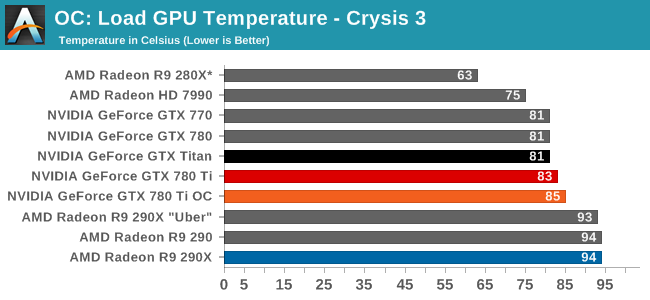

Despite the 95C temperature target we use for overclocking, the GTX 780 Ti finds its new equilibrium point at 85C. The fan will ramp up long before it allows us to get into the 90s.
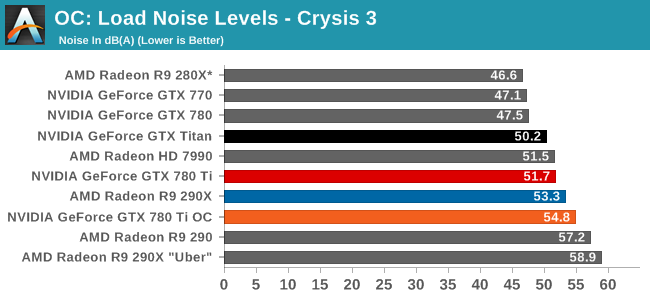
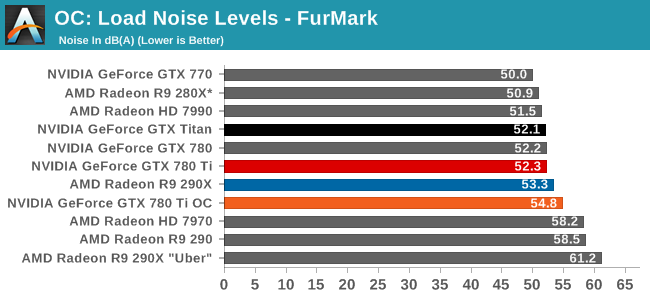
Given the power jump we saw with Crysis 3 the noise ramp up is surprisingly decent. A 3dB rise in noise is going to be noticeable, but even in these overclocked conditions it will avoid being an ear splitting change. To that end overclocking means we’re getting off of GK110’s standard noise efficiency curve just as it does for power, so the cost will almost always outpace the payoff on a relative basis.
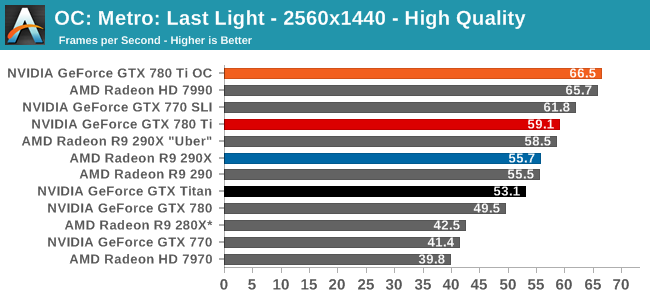
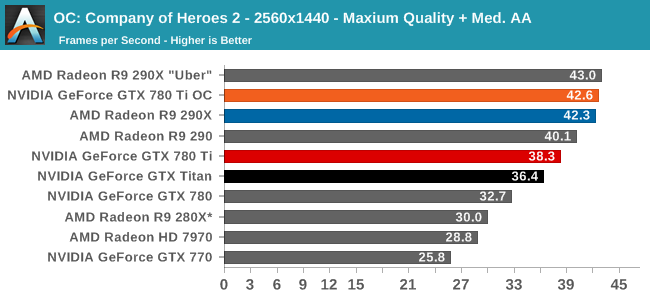
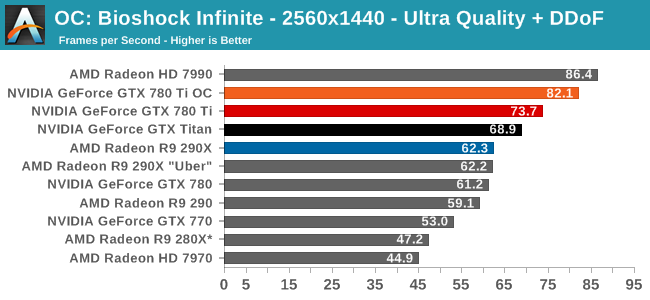
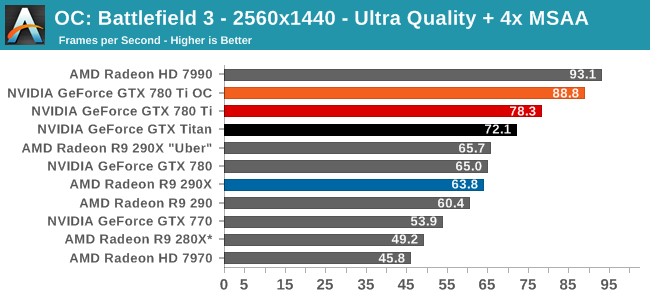
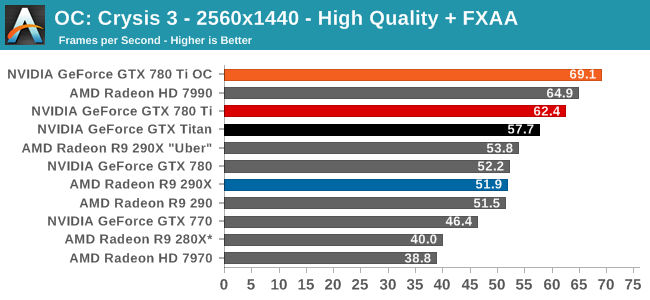
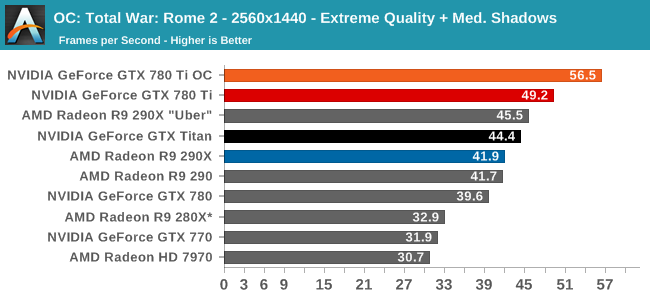
Finally, looking at gaming performance the the overall performance gains for overclocking are generally consistent. Between our 6 games we see a 10-14% performance increase, all in excess of the memory overclock and closely tracking the GPU overclock. GTX 780 Ti is already the fastest single-GPU card, so this only further improves its performance lead. But it does so while cutting into whatever is above it, be it the games where the stock 290X has a lead, or multi-GPU setups such as the 7990.










302 Comments
View All Comments
Kutark - Friday, November 8, 2013 - link
The argument was never whether one or the other was a better value but rather which is the better card. Thats what this discussion is about. Anybody with their head not firmly planted in their ass can see the 290x is a good value. The problem is value changes from person to person. Some people don't care how noisy their video card is. Some people don't care how hot it runs under load. Those people would find that card to be an excellent value. Other people do care. For them it might be worth it to pay extra for a quieter card that runs 8-10c cooler. Just like some people don't give 2 shits about having leather seats in their car, and don't think a $2000 option for leather would be a good value. Others think its great.Secondly, the Ti only loses to the 290x at 4k resolution which is a complete non point as there is all of 1 4k monitor out right now and it costs 2x of what most people spend on their computer. Lets not also mention that to get decent framerates you need a minimum of 2x of the 780/Ti's or the 290/Xs, So we're talking about a 5k investment outside of the rest of your shit to play at 4k? Id be willing to bet less than 1 in million PC gamers have that much money into their rigs
Mondozai - Friday, December 13, 2013 - link
AMD fucked up with their reference cooler, and they fucked up with not providing data early enough to OEMs for aftermarket coolers. But comparing stock 290/290X to the GTX 780 Ti is misleading. You have to compare both cards when there are aftermarket coolers to both of them.But you don't do that. Why? Because you know an aftermarket cooler isn't going to be a big difference to 780 Ti, but it will make a massive difference to 290/290X.
Stock versions of both cards with aftermarket cooler from the same OEM will show very little variance in performance at higher(1440p and above) resolutions. Except that 780 Ti will remain completely overpriced.
Price to performance ratio isn't just about budget and middle segment cards. You can do the same to high-end cards. A 290X with an aftermarket cooler is simply going to beat out 780 Ti in anybody's but a fanboy's eyes. Sorry, but you're fanboying.
And I am saying that as an Nvidia card owner myself, but the fact remains that Nvidia has been able to rape the wallets of a lot of people for so long, and I blame AMD for this, that some people like you have internalized the raping and come to defend it.
I can only look at you with pity.
Owls - Thursday, November 7, 2013 - link
Ryan I'm sorry but the video card reviews as of late have been very poor in quality and objectivity. Stop rushing to be the first. I don't go to Anand to read a crappy review, that's what HardOCP is for.That said your testing is flawed with old games and comparing the Ti to be faster than a 290x that is in silent mode is disingenuous. We all expect better from this site.
ol1bit - Thursday, November 7, 2013 - link
First, Fantastic Review as always!As a side note, it's amazing to me that AMD can't get the performance with the same heat output as Nivida. After all they are a semi-big chip company, what gives?
FuriousPop - Thursday, November 7, 2013 - link
wow! as a current AMD owner, i must say it is impressive. Temps and noise great! - power consumption not as much as expected, but hey a good card indeed. Now if only we could see the benchmarks in the higher areas of 1600p+. If your going to make a comment of overkill at 1440p with SLi of these, then why not show 1600p then and see how it really matches up!?i know that it in the past has been AMD for >1440p and Nvid for 1080< but as of late, we are starting to see that change dramatically.
Can we please see some 1600p and 1600p+ res being tested on benchmarks! if there were already those benchmarks out and showed impressive results at higher resos i prob would of gone out and bought 2x of these ASAP. however will have to wait and see...
AnotherGuy - Thursday, November 7, 2013 - link
So Ryan, you made the R9 290 as a total disappointment because it had a little higher noise than the rest at the time, but now when you see the 780 getting close at 52dB this is a little high but ok for nVidia and they won...That is not fair.You need to control those emotions, think many times and then finally find the right words to describe a product, not let your first thought into the final conclusion of a review.
Ma Deuce - Thursday, November 7, 2013 - link
You need to control those emotions. Think many times and then finally find the right words to criticize a review, not let your first thought into the comment...290 is loud and hot and he didn't recommend it. Sorry man, it's not the end of the world though. You can buy it without their expressed written consent.
sf101 - Friday, November 8, 2013 - link
Anotherguy your right though on the 290x review they made it sound like the end of the world over the noise /temp and power use levels.Yet when Nvidia does it its ok.
And everyone just does a point in other direction look its super man type thing and pretends it didn't happen.
If your going to be nit picky about noise and heat then at-least be consistent from what I've seen both the 290 and 780ti are fairly close in wattage use now so there goes your TDP arguments.
And just because Nvidia has a better reference cooler doesn't change the fact that it still is using similar wattage to the 290/290x the only difference is Nvidia's cooler deals with it a bit better.
just finding the review a tad bias ,,,,,,,
Morawka - Friday, November 8, 2013 - link
the 290 got up to 62 dbformulav8 - Monday, November 11, 2013 - link
Ryan's reviews has stunk for awhile now. I used to defend him and anand on appearing bias and such. But there does seem to be something. And the thing is that if it is true, they could care less. Literally